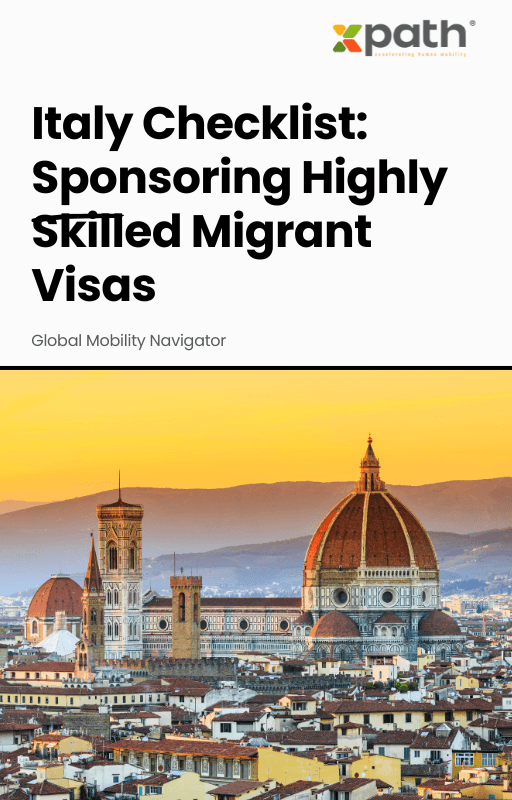Italy Checklist: Sponsoring Highly Skilled Migrant Visas
Grab a copy of a guide to international employee relocation
View E-bookGlobal mobility has emerged as a vital component of business growth in today’s interconnected economy. Whether you’re a multinational company sending professionals overseas for project work, or an employee embarking on an international assignment, understanding the nuances of social security detachments and A1 certificates could mean the difference between smooth operations and bureaucratic nightmares. If you’ve ever puzzled over how to ensure your expatriates remain compliant while keeping costs manageable, keep reading—this is your must-have guide.
In the world of international employment, it’s not just about booking flights and organizing visas. The rules around social security can be a major stumbling block for companies expanding into new markets. Social security detachment mechanisms, such as A1 certificates in the European Union (EU), allow employers and employees to maintain their home-country contributions for a defined period. This means no double payments and fewer administrative headaches. Without proper planning, however, businesses face financial penalties, compliance risks, and even disgruntled employees. The stakes are high—but so are the rewards for getting it right.
Let’s break it down to basics. Social security detachment, sometimes called ‘certificate of coverage,’ is essentially a permission slip for an employee temporarily working abroad. The most recognized example is the A1 certificate (formerly E101) within the EU and EEA. This document proves that the employee continues to be subject to their home country’s social security law, rather than the country where they’re temporarily working.
This setup is designed to prevent double contributions—which can add up fast. For example, in France, combined employer and employee social contributions can reach over 45% of salary. Without detachment, those costs may need to be paid in both countries, drastically increasing outlays for firms and employees alike.
The appetite for cross-border work is at an all-time high. A 2023 Deloitte survey showed that 92% of multinational organizations plan to increase global assignments in the next two years. Simultaneously, PwC’s Emerging Trends in Tax found that nearly 60% of mobility leaders identify navigating social security requirements as a primary compliance challenge.
The stakes aren’t just theoretical. Eurostat data highlights that nearly 3.3 million EU citizens worked temporarily in another member state in 2022. Meanwhile, a lack of proper A1 certificate coverage led to fines for over 13% of companies audited between 2019 and 2022, according to a European Commission compliance report.
Consider the story of a German engineering firm with a major project in Poland. In their rush to mobilize talent, they overlooked the A1 application. Six months later, a Polish audit revealed missing social security documentation, resulting in a €100,000 penalty. The team lost months appealing the charges, while employee morale took a nosedive. If only they’d secured those certificates!
Contrast this with organizations leveraging xpath.global’s mobility solution platform. By automating A1 certificate requests and providing tailored compliance alerts, companies report a 40% reduction in administrative time spent managing social security detachment across Europe, all while enhancing their compliance record.
Sure, on paper, A1 certificates look straightforward. But real-world mobility is rarely that simple. For starters, not all countries have the same approach or digitized systems. Application timelines can range from a few days in Denmark to over two months in Italy. Plus, changing assignment scopes or durations can trigger sudden certificate invalidation.
The COVID-19 pandemic further complicated matters, with remote work blurring the lines between host and home countries, making compliance even trickier. Employees ‘working from anywhere’ run the risk of unintended social security liability if the right paperwork isn’t in place.
The future of global mobility lies in digital transformation. Innovative platforms like xpath.global streamline the end-to-end process of managing A1 certificates and social security detachments. Imagine dashboards that track the status of every outbound assignee, automated reminders for renewals, and instant compliance checks against the latest country-specific rules.
This data-driven approach not only reduces the risk of non-compliance and penalties but also frees up HR teams to focus on what really matters: supporting talent and driving business forward. With centralized documentation and smart analytics, companies can scale their mobility programs confidently and cost-effectively.
Social security detachment and A1 certificates are no longer niche bureaucratic concerns—they’re critical levers in the global competition for talent. The risks of getting it wrong are glaring, but with the right knowledge and solutions in your toolkit, compliance can become a springboard for strategic growth. If you’re looking to simplify the process, slash costs, and empower your mobile workforce, take a fresh look at how technology partners like xpath.global can be the game-changer your business needs. Don’t let paperwork hold back your progress—transform the way you move talent, today.
What is an A1 certificate?
An A1 certificate is an official document that proves an employee remains subject to their home country’s social security system while temporarily working in another EU/EEA country or Switzerland.
Why is social security detachment important?
It prevents double payment of social security contributions, saving money and ensuring continued benefits for employees on assignment.
How long is an A1 certificate valid?
Typically up to 24 months, but this may vary by country and assignment details. Extensions can sometimes be requested for longer projects.
What happens if I forget to apply for an A1 certificate?
The employee may be liable to pay social security in the host country, and the employer could face significant fines and compliance issues.
How does xpath.global help with A1 certificates?
xpath.global offers an integrated platform for automating A1 certificate applications, tracking compliance, and minimizing administration with real-time updates and alerts tailored to each assignment.
Ready to transform your mobility program? Explore xpath.global’s solutions.

Italy Checklist: Sponsoring Highly Skilled Migrant Visas
Grab a copy of a guide to international employee relocation
View E-book